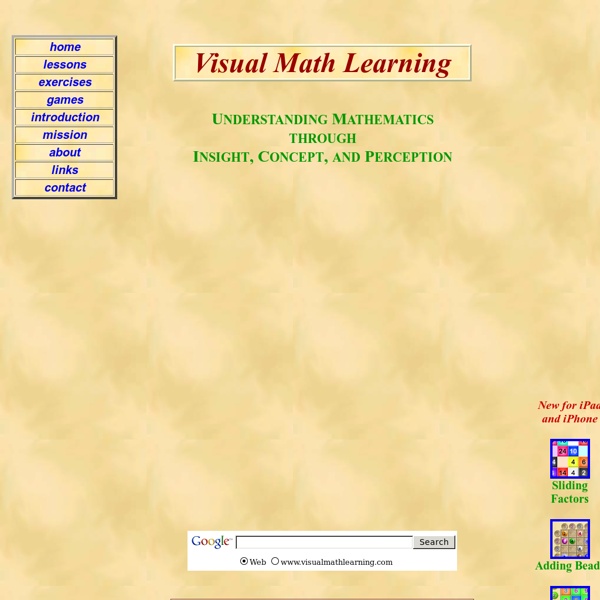



Dimensions Accueil Un film pour tout public. Neuf chapitres, deux heures de maths, pour découvrir progressivement la quatrième dimension. Vertiges mathématiques garantis! Trouvez des informations supplémentaires pour chaque chapitre : voir "En détail". Cliquez sur l'image à gauche pour voir la bande-annonce (branchez vos haut-parleurs). Ce film est diffusé sous une licence Creative Commons. Maintenant avec encore plus de langues de commentaires et sous-titres : Commentaires en allemand, anglais, arabe, espagnol, français, italien, japonais et russe. Film produit par :Jos Leys (Graphiques et animations)Étienne Ghys (Scénario et mathématiques) Aurélien Alvarez (Réalisation et post-production)
Mental Math Mental Math - A Guide to Effective Mental Calculations[edit] Note about Notation: This book generally uses the English/U.S. styles of notation. This includes using commas as a way to divide up the thousands in long numbers (e.g. 32,000 = thirty-two thousand), it will use full stops (periods) as decimal points. Calculating things in your head can be a difficult task. With good mental math skills you can save yourself time by not needing to pull out a calculator (or cell phone) every time you want to do a task.Mental math skills will improve your ability to estimate results, thus having a better ability to catch errors from computer-derived results. Addition[edit] The foundation of all arithmetic is addition, also known as summing. Changing the Order of Addition[edit] Often when looking for a pattern to help you quickly do an addition problem, it can help to change the order that you add things. Adding Zero, One, or Two[edit] Adding Nine or Eight: Counting Down from 10[edit] Subtraction[edit]
Coin flipping Tossed coin. Coin flipping, coin tossing, or heads or tails is the practice of throwing a coin in the air to choose between two alternatives, sometimes to resolve a dispute between two parties. It is a form of sortition which inherently has only two possible and equally likely outcomes. History[edit] The historical origin of coin flipping is the interpretation of a chance outcome as the expression of divine will. Coin flipping as a game was known to the Romans as navia aut caput ("ship or head"), as some coins had a ship on one side and the head of the emperor on the other.[1] In England, this game was referred to as cross and pile.[1][2] The expression Head or Tail may stem from the German expression for the same game: Kopf oder Zahl ("head or number") hinting at a mispronunciation of the word "Zahl" into "Tail". Process[edit] During coin flipping you throw the coin into the air such that it rotates end-over-end several times. Fraudulent flipping[edit] Three-way[edit] Politics[edit]
Four-triangle Arrangements Well, equilateral triangles are great fun to play around with (try Triangle Animals if you haven't already!) but let's not forget the right-angled triangle - particularly the kind that comes from cutting a square in half through a diagonal. We could take 4 of these and have something like this: So we can make some rules about how we can re-arrange these four triangles. The four arrangments above would obey the rule. So, using plastic, paper, card or other triangles, what arrangements can you make with four right-angled isosceles triangles like the ones at the start? Like in so many investigations it's good after a while to change a bit of the rule and start again. For example the red and orange ones we've already seen above are now allowed: Others might be: Now it's your turn.
Sigmoïde (mathématiques) Un article de Wikipédia, l'encyclopédie libre. Pour les articles homonymes, voir Sigmoïde. La fonction sigmoïde En mathématiques, la fonction sigmoïde (dite aussi courbe en S) est définie par : pour tout réel mais on la généralise à toute fonction dont l'expression est : Le nom de « sigmoïde » lui vient de sa forme en S. Elle est souvent utilisée dans les réseaux de neurones et représente la fonction de répartition de la loi logistique. La courbe sigmoïde possède pour asymptotes les droites d'équation y = 0 et y = 1. La fonction sigmoïde avec Pour une courbe sigmoïde de paramètre λ la tangente au point d'inflexion est λ/4. Les propriétés de la fonction sigmoïde s'expliquent par celles de sa dérivée. qui peut se transformer en . y varie de 0 à +1. La dérivée seconde possède aussi quelques propriétés : elle peut se transformer en ce qui vérifie bien qu'un point d'inflexion est le point-milieu y=½. La raideur de ces fonctions aussi nommées "sigmoïdes de Hill" est décrite par le paramètre . , mais en
Shape, Space and Measure Resources 2D Shapes Properties of Quadrilaterals Dominoes- a superb set of dominoes that gets pupils to explore the shape properties of quadrilaterals. Made by the excellent www.notjustsums.com website and published on www.tes.co.uk Shape properties of quadrilaterals investigation- a super NRich Maths investigation into shape properties of quadrilaterals Angles Properties of 2D Shapes Investigation- investigate the angle properties of 2D shapes. Do The Nonagon- a funny YouTube video about polygon names 2D Shape Names Prezi- an engaging Prezi showing 2D shape names Polygon Shape Properties Top Trumps- a wonderful collection of Top Trump cards based on shape properties of polygons 2D Shape Reveal Game- an excellent game where a 2D shape is slowly revealed and pupils have to guess the shape from it’s properties 3D Shapes MathsNet 3D Shape Resources- a selection of excellent interactive applets based on 3D shape activities. NRich Maths What Does The Cube Look Like? Angles Area Bounds Circles Circle Theorems Loci